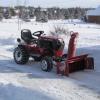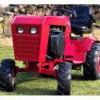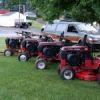-
Similar Content
-
 By Hydro
By Hydro
I recently bought a 1994 tall chute single stage snow thrower, model 79360. I have replaced the chain, both idler sprockets, both idler pulleys and one jack shaft bearing on the chain side. The auger is strait and the bearings are smooth. It runs quietly. I have it mounted on my 314H powered by a Kohler M16. I am shearing the pulley key on the jack shaft. It has happened twice now. The first time it threw the set screw so I thought it was a matter that the screw was not tight enough. Toro shows one screw although the pulley is drilled and tapped for two. I was careful I thought when I positioned and tightened that screw. After the first time, 20 minutes running, I added the second screw. I also noticed the pulley has some wobble to it so I used some shim stock in order that there would be no play between the shaft and the pulley. I ran it for about 20 minutes again and noticed both screws were loose so I used Loctite 242. I let that sit for about 30 minutes and went out again. In about 20 minutes I sheared the new key right off with a portion of it in the keyway of the pulley. The shaft is clear of the key but has been scored some.
My driveway is paved. I was plowing before and built up some snow banks. The first time I sheared the key, the thrower was mainly resting on the scraper blade and I was just removing snow from the driveway, I thought I might have jammed it with some ice. The second time I raised the thrower to give it clearance so there was about 3/8†between the blade and the runners which I adjusted.
I ease the machine into snow and creep along. I do not ram it into snow banks. I’ve seen videos of these things working really well. Mine was blowing snow beautifully but something is not right. Is it the fit between the pulley and the jackshaft? Why would Loctite not hold the set screws? What is wrong with my machine or what I’m doing wrong?
I have to suspect there is a weak point where something will give or the belt will just slip. My belt is new and has the correct Toro Part number. It fits the way I have seen them mounted so I doubt that has any part of what is happening.
I would appreciate your thoughts.
Thanks
Gary
-
 By Hydro
By Hydro
I've been reading through various chain & bearing repair posts regarding the snow thrower. I have just acquired a 1994. The auger, jack shaft bearings and drive sprocket are in good shape. The blower needs idler pulleys, a chain and the inside sprockets. The auger sprocket rotates with about a 1/4" of wobble and the teeth are getting sharp. Is it normal for the auger sprocket to be off a little when manufactured? The auger itself runs true. Not sure how far to go with the rebuild as I know the auger sprocket would have to be re-done at a machine shop. Here are a couple of pictures of the sprocket teeth. What do you think?
Thanks for your time.
-
 By Martin
By Martin
trying to determine whether i have a good trans or not and have a question or more.
i have an eaton 1100 in a rolling chassis that i want to test to see if its working well enough to justify using in a new tractor rebuild. i hooked it up to my 1848 pto with a longer mower belt to test it out. oil looks very clean so i left it and i know i need to get the correct filter on there, but for now its staying until i see some light at the end of the tunnel.
just did a quick test tonight to see if i could at least get the lift to work. success on the first pull of the lever. hydro pump seems very quiet and no leaking or damp areas either. i worked the lift up and down from one extent to the other and it worked as good as any nice working lift i have. so I'm happy so far, now the questions......
to test the drive I'm going to get it up off the ground and see if i can get the wheels to turn in either direction. i want to run it this way for quite a while until i can get some raising of oil temp.
is putting weight on the lift going to change anything as far as a test goes? i figure if it goes up and down, is quiet doing so and doesn't leak, I'm 99 % there....
is there any way to check to see if it is loosing pressure when it gets warmer?
can a gauge be hooked up and is this easy enough to do?
is it even worth finding out the pressures? what will having them tell me?
is this a good enough way to test the whole hydro system? i think it will tell me at least if its working and if there are any leaks. i don't have a working engine that i can just throw in there to drive it around without puling one of my old starter gen motors from an unrestored 1277. i know this is probably the best way, drive it and get it nice and hot to be sure. i could swap it out from one of the other 1100s but then i got to deal with hoses etc and not really interested in pulling apart good working systems and opening other cans of worms.
while it was running, and over the noise of the engine in the 1848, the pump seemed to be very quiet, quieter than the other 2 1100 tractors are. both of the other 1100s work well and aside from one having a leak in the lift, they both are leak free.
ao at this stage i am happy with how things are going. just wondering if there was some expert opinions to help me on my way with some ideas.....
thanks in advance for any input, fire away guys.....
-
 By FZR
By FZR
Does anyone know where I can get a Routing Diagram for an LT-1100 3-Speed Drive Belt. I'm looking for the routing diagram for the drive belt that runs from the engine to the transmission. Any help would be appreciated.
-
 By B-8074
By B-8074
Will a tiller for a 5xi work on my C-175 without having to do any modifications?
-

